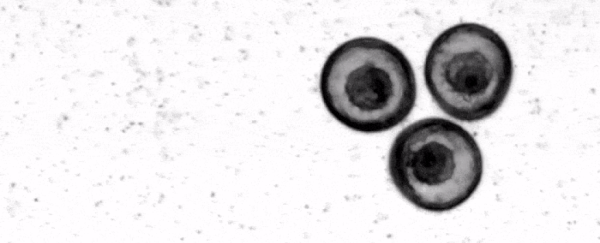Tiny gelatinous blobs spin perfect pirouettes in the water – their movement whipping up a force that attracts their neighbors. As enough of them gather together, this synchronized dance aligns them into precise six-sided, ordered, repeating patterns, just like carbon atoms in a graphene crystalline structure.
But these aren't atoms or any type of inanimate matter governed merely by forces of physics – they're living, self-moving, embryonic sea stars (Patiria miniata).
 Spinning sea star embryos gathering themselves into a living crystal. (Tan et al., Nature, 2022)
Spinning sea star embryos gathering themselves into a living crystal. (Tan et al., Nature, 2022)
"We know we have crystals of many materials but we have never really related the formation of a crystal with components that are actually living," MIT physicist Nikta Fakhri told Nature.
"This was an absolutely remarkable phenomenon that has never been reported before."
Fakhri, MIT physicist Tzer Han Tan and colleagues study active matter – systems where each individual component (such as a bird in a flock, or a cell in a drop of water) uses energy to move about, throwing the whole group out of balance with its surroundings.
Like ordinary matter, these systems can also have surprising, emergent properties. The sea star 'crystals' are no exception.
Each embryo spins itself in a left-handed direction using its hair-like cilia. When enough individuals gather at the surface of the water, spontaneous ripples start flowing through the structure they've formed.
They're very large-scale waves, as large as the crystal itself, explains Fakhri.
 Model of the ripples with arrows and color coding to indicate each embryo's direction. (Tan et al., Nature, 2022)
Model of the ripples with arrows and color coding to indicate each embryo's direction. (Tan et al., Nature, 2022)
"We could see this crystal rotating and jiggling over a very long time, which was absolutely unexpected," says Alexander Mietke, a theoretical biophysicist at MIT and study author.
"You would expect these ripples to die out quickly, because water is viscous and would dampen these oscillations. This told us the system has some sort of odd elastic behavior."
The researchers modeled the embryos' movements to see how their spin pulls water towards themselves. This in turn pulls their twirling neighbors towards them too, in a reciprocated attractive force.
But that water, which ends up flowing down, also creates another horizontal force that isn't reciprocated within the system. This causes the entire crystal structure to rotate as well.
Both the overall rotation and the waves demonstrate the physics traits of odd elasticity. It's odd because according to classical laws of physics, simply deforming an isolated solid object, such as a crystal floating in water, under a specific set of circumstances shouldn't power it through the environment.
However, if an object consists of active components, this overall morphing in shape could have some interesting mechanical properties.
At least, that's the theory. In reality, it's still an area of physics being explored.
There are some intriguing possibilities arising in nature. A similar phenomenon has also been observed before in algae.
 The spinning crystal-like structure dissipates after around 30 hours. (Tan et al., Nature, 2022)
The spinning crystal-like structure dissipates after around 30 hours. (Tan et al., Nature, 2022)
Once the baby sea stars form the floating, living crystal structure it holds itself together for days before the embryos' development changes them enough to shatter the pattern.
Understanding these animate physical properties better could help us develop new technologies.
"Imagine building a swarm of soft, spinning robots that can interact with each other like these embryos," says Fakhri.
"They could be designed to self-organize to ripple and crawl through the sea to do useful work. These interactions open up a new range of interesting physics to explore."
As for why the baby sea star galaxies – yes, sea stars have the most perfect collective noun! – form crystalline structures when they gather, it is currently a mystery.
However, this living crystal phenomenon is unlikely to occur naturally in the wild as sea star embryos don't usually hang out at the water's surface.
This research was published in Nature.
